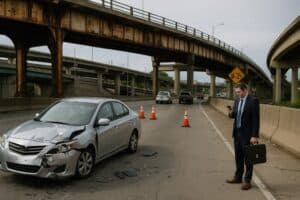Transportation is often viewed as a symbol of progress: well-paved roads, towering bridges, and expanding highways suggest efficiency and safety. Yet beneath the surface of these seemingly reliable systems lie risks that can catch even the most cautious driver off guard. From poorly designed intersections to outdated infrastructure, the unseen dangers within our transportation networks can drastically increase the severity of accidents. For those affected, the support of a trusted personal injury attorney in Wichita becomes essential in uncovering responsibility and seeking rightful compensation.

The Hidden Role of Roadway Design
When drivers set out each day, they rely on the assumption that roads are built with safety as a priority. However, the truth is that many roadways were designed decades ago, long before today’s traffic volume and vehicle speeds were imaginable. Sharp curves without proper signage, blind intersections, and confusing lane merges often create conditions where accidents become almost inevitable. Drivers usually discover these flaws only when it is too late.
For instance, certain rural highways lack the guardrails necessary to prevent vehicles from veering off course, while some city intersections are notorious for accidents due to insufficient signal timing. These are not reckless driving issues; they are systemic flaws hidden within the infrastructure itself.
Aging Infrastructure and Silent Threats
Aging infrastructure presents another layer of hidden danger. The United States faces significant challenges, including outdated bridges and deteriorating roads, many of which are classified as structurally deficient. These conditions might appear harmless during daily commutes, but they increase the likelihood of catastrophic failures in high-pressure situations such as storms, heavy traffic, or unexpected detours.
Potholes, crumbling concrete, and uneven road surfaces can cause drivers to lose control of their vehicles without warning. Even minor defects, if left unaddressed, can lead to tire blowouts or loss of steering, especially at highway speeds. The danger is not always obvious, but the consequences are often devastating.
Overlooked Complexity of Traffic Flow
The way traffic moves through a city is more than just vehicles stopping and going. Transportation planners must account for human behavior, peak-hour congestion, and unpredictable patterns. Unfortunately, traffic systems sometimes fail to anticipate how drivers actually respond under stress.
A poorly timed traffic light can trigger aggressive driving or red-light running. Likewise, insufficient lanes during rush hour create bottlenecks that heighten the risk of rear-end collisions. When traffic systems do not evolve with population growth, the result is an environment where even cautious drivers are forced into dangerous situations they never anticipated.
The Impact of Technology and Distraction
Technology has transformed driving, but it has also exposed weaknesses in our infrastructure. GPS systems, for example, often route drivers through residential streets or underdeveloped roads not designed for high traffic volume. Meanwhile, many traffic signs and markings are not equipped to handle the split attention of drivers distracted by smartphones or onboard screens.
When infrastructure lags behind technological change, the safety net collapses. Ordinary drivers may be lulled into a sense of security, believing navigation systems will guide them safely. Yet, the reality is that technology magnifies risks when paired with inadequate or outdated infrastructure.
Weather and Environmental Factors
Nature also plays a critical role in exposing the flaws of transportation systems. Roads not engineered with proper drainage quickly become slick during heavy rain, creating hydroplaning risks. Bridges without anti-icing measures become dangerous in winter. Similarly, urban heat can warp pavement, creating uneven surfaces that destabilize vehicles.
These dangers are not typically on a driver’s mind during a routine commute. Yet, infrastructure that does not account for environmental realities places unsuspecting drivers in harm’s way when the weather turns severe.
Why Accountability Matters
While drivers are often blamed for accidents, systemic issues within infrastructure cannot be ignored. Holding municipalities, contractors, and government agencies accountable for unsafe conditions is vital. This process, however, requires extensive knowledge of transportation law, engineering standards, and liability practices.
Victims often discover too late that proving negligence related to infrastructure is a complex undertaking. Here is where consulting with a trusted personal injury attorney in Wichita can make all the difference. Attorneys with this expertise can investigate beyond the driver’s actions, uncovering whether poor road design, lack of maintenance, or inadequate signage played a direct role in the accident.
The Cost of Neglect
The financial and emotional costs of infrastructure-related accidents are staggering. Medical bills, rehabilitation, vehicle damage, and lost wages can overwhelm families. But beyond personal expenses, there is a broader economic burden. Poor road conditions alone cost drivers billions each year in repairs and accident-related expenses.
For drivers, these figures represent more than statistics; they underscore the fact that hidden dangers are not just rare anomalies but systemic issues that directly affect daily lives.
Building Safer Futures
The solution lies in forward-thinking investments. Communities must prioritize safety audits, infrastructure modernization, and the integration of technology into their traffic management systems. Roads should be built not only to handle current conditions but also to anticipate future demands. Transparent reporting and accountability mechanisms ensure that weak points are identified and addressed before a tragedy occurs.
In the meantime, victims of crashes caused by poor infrastructure need avenues for justice. The guidance of a trusted personal injury attorney in Wichita ensures that hidden dangers do not go unchallenged and that individuals have the support they need in the aftermath of preventable accidents.
Conclusion
The dangers hidden within transportation systems and infrastructure are rarely visible until lives are forever changed. Outdated designs, neglected maintenance, and inadequate planning combine to create risks that ordinary drivers cannot foresee. While systemic change is essential, those already affected by these failures deserve immediate support and advocacy. With professional legal guidance, victims can navigate the complex path to accountability and ensure their voices are heard.